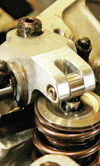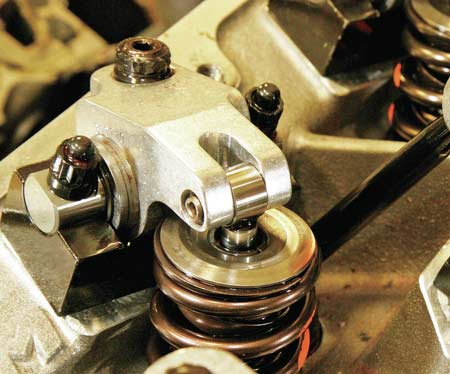Rocker stands
 In the previous article on rocker stands, and as a general theme to the subject of pushrod valvetrains, the importance of stiffness was stressed. Also important though is that the mechanism is set up on the engine as intended when designed.
In the previous article on rocker stands, and as a general theme to the subject of pushrod valvetrains, the importance of stiffness was stressed. Also important though is that the mechanism is set up on the engine as intended when designed.
This means that the relationship between the tip of the valve, the roller tip and rocker pivot are as designed. Not only does a badly set-up mechanism deviate away from the designed valve lift profile, but the relationship of the contact between the valve tip and roller compared to the valve axis is wrong. This can lead to unintended bending stresses in the valve, and this in turn can lead to problems such as valve guide wear.
There are three major variables in the equation here, each of which can be modified independently by component selection. First, we have a variable-length valve, by virtue of having a range of lash caps at our disposal of varying thickness. Second, we can order pushrods of almost any length we might desire. The third variable is the height of the rocker stand axis.
Essentially, for a given combination of rocker geometry, valve geometry and valve lift, there will be an ideal height from the top of the lash cap to the axis of the rocker. While people can have different ideas about which point in the valve lift cycle the roller axis and valve axis should intersect, most would deliberately avoid putting excessive bending into the valve stem. For teams running the rollerless rocker designs that have been used by some of the Sprint Cup teams in recent years, the problem of bending is likely to be more of a concern, with a greater coefficient of friction being present between lash cap and rocker.
The suppliers of pushrods and associated components are pretty clear that you need to have this relationship between valve tip and rocker pivot axis correct, and only then specify the pushrod length. People who simply try to accommodate a collection of good parts they have to hand are inviting trouble.

A number of suppliers manufacture checking tools that are simple to use and ensure that an engine builder always gets the correct geometry. Of course, if you are running something unusual and special to your engine, you will need to design your own jig or modify an existing one.
Other suppliers specify a procedure during which you check by eye that the roller contact moves across the top of the valve, with the extremes of travel being equidistant from the valve axis. If the centre height of the rocker pivot is too high compared to the valve tip, the options are to fit a longer valve or a thicker lash cap, or machine the base of the rocker stand or the seat area on the cylinder head. If the pivot height is too low, the options include fitting shorter valves, thinner lash caps or shims under the rocker stands. The procedure, whether using a bespoke tool or checking the 'sweep' of the rocker over the valve tip by eye, may involve building the components onto the head a few times.
In the case that the rocker stands incorporate mountings for a number of rockers, they cannot be shimmed to each individual valve, and adjustment of lash caps is likely to be required.
Fig. 1 - The height of rocker stands carrying individual rockers can be adjusted to suit the individual valve they operate
Written by Wayne Ward